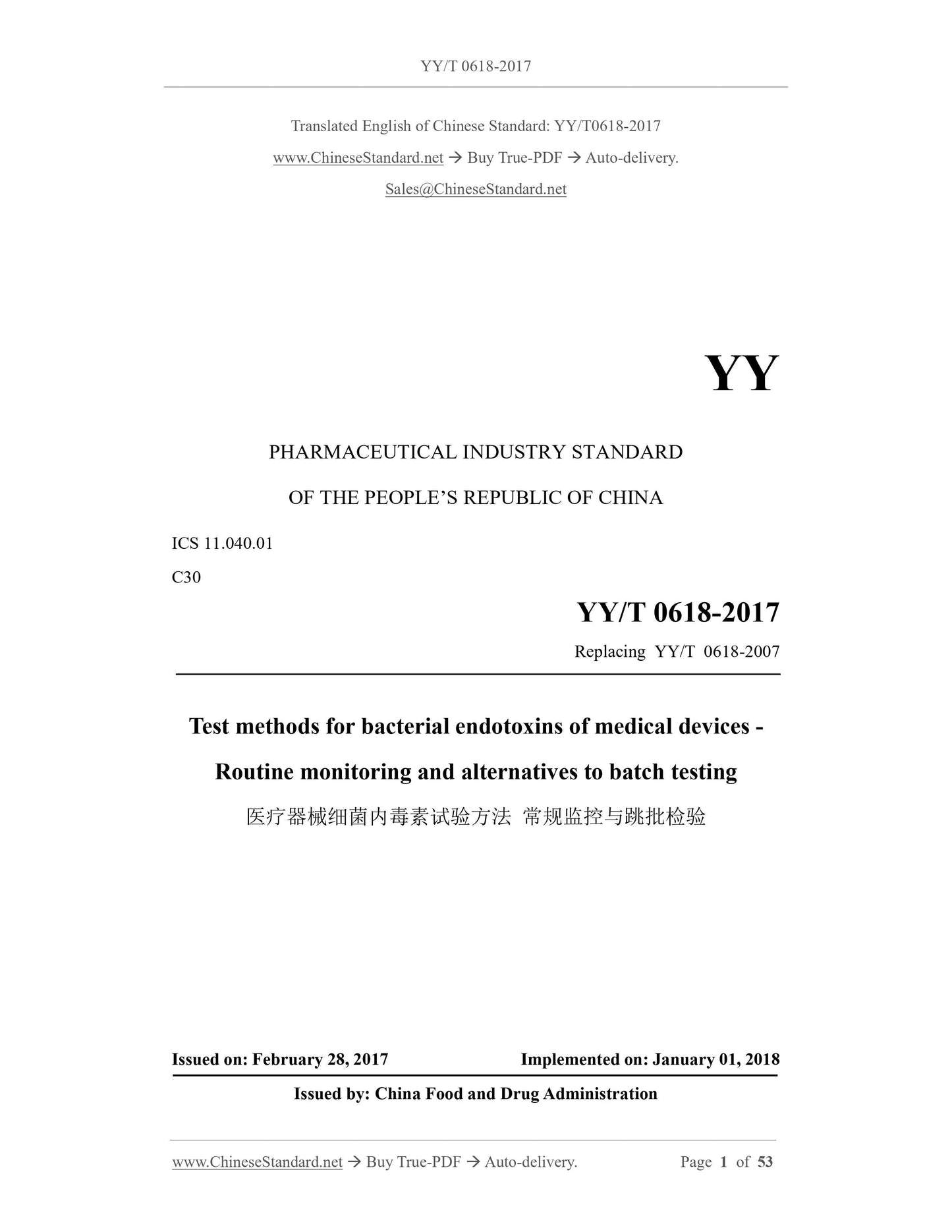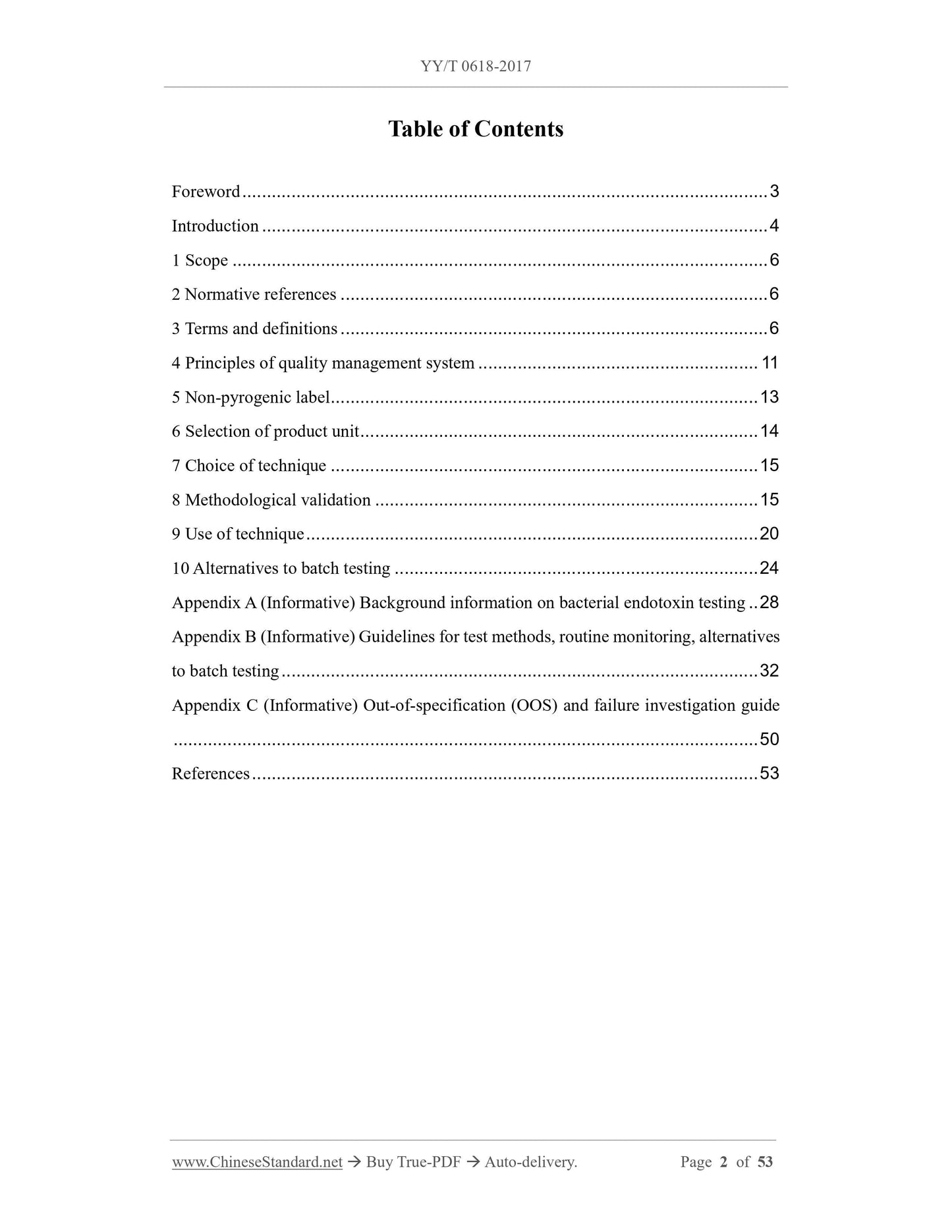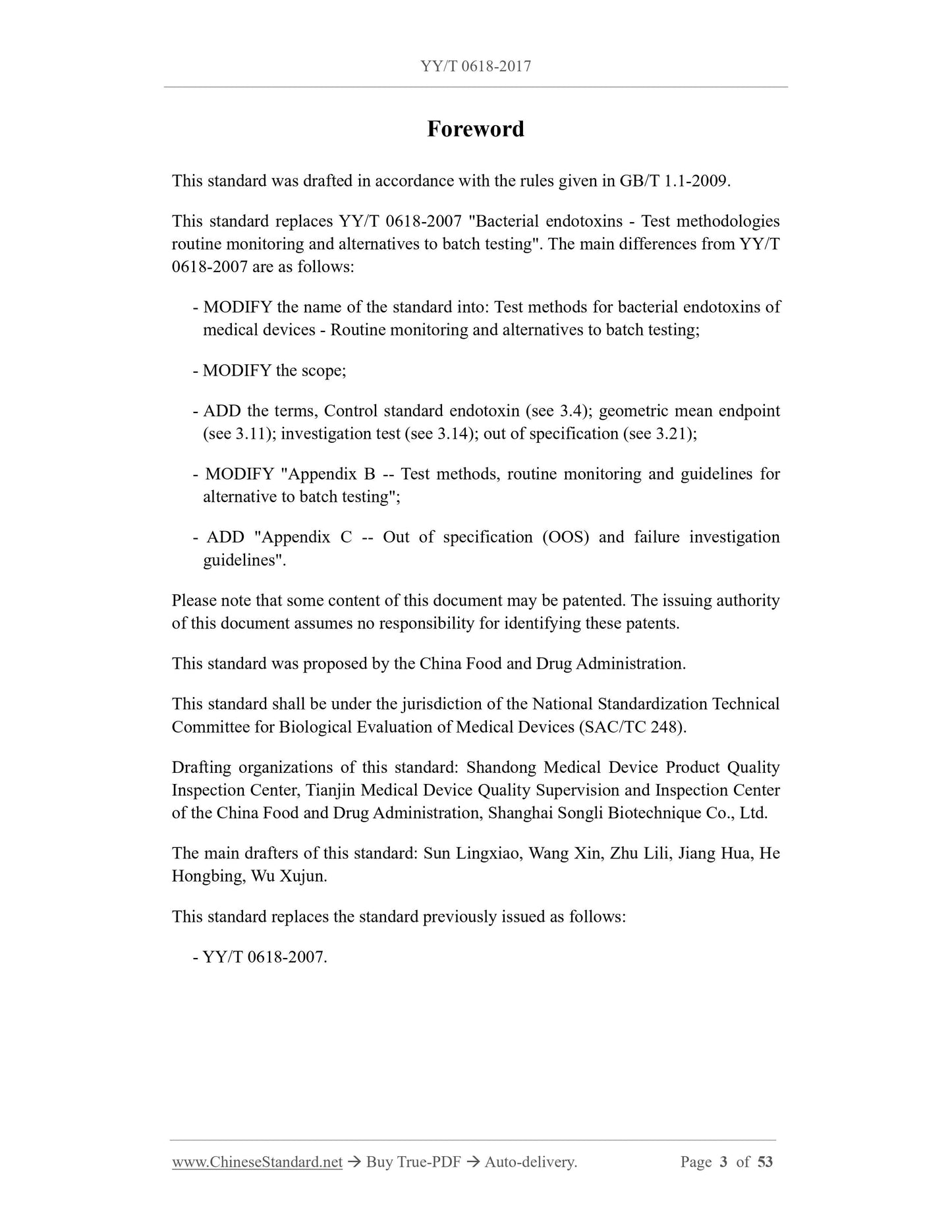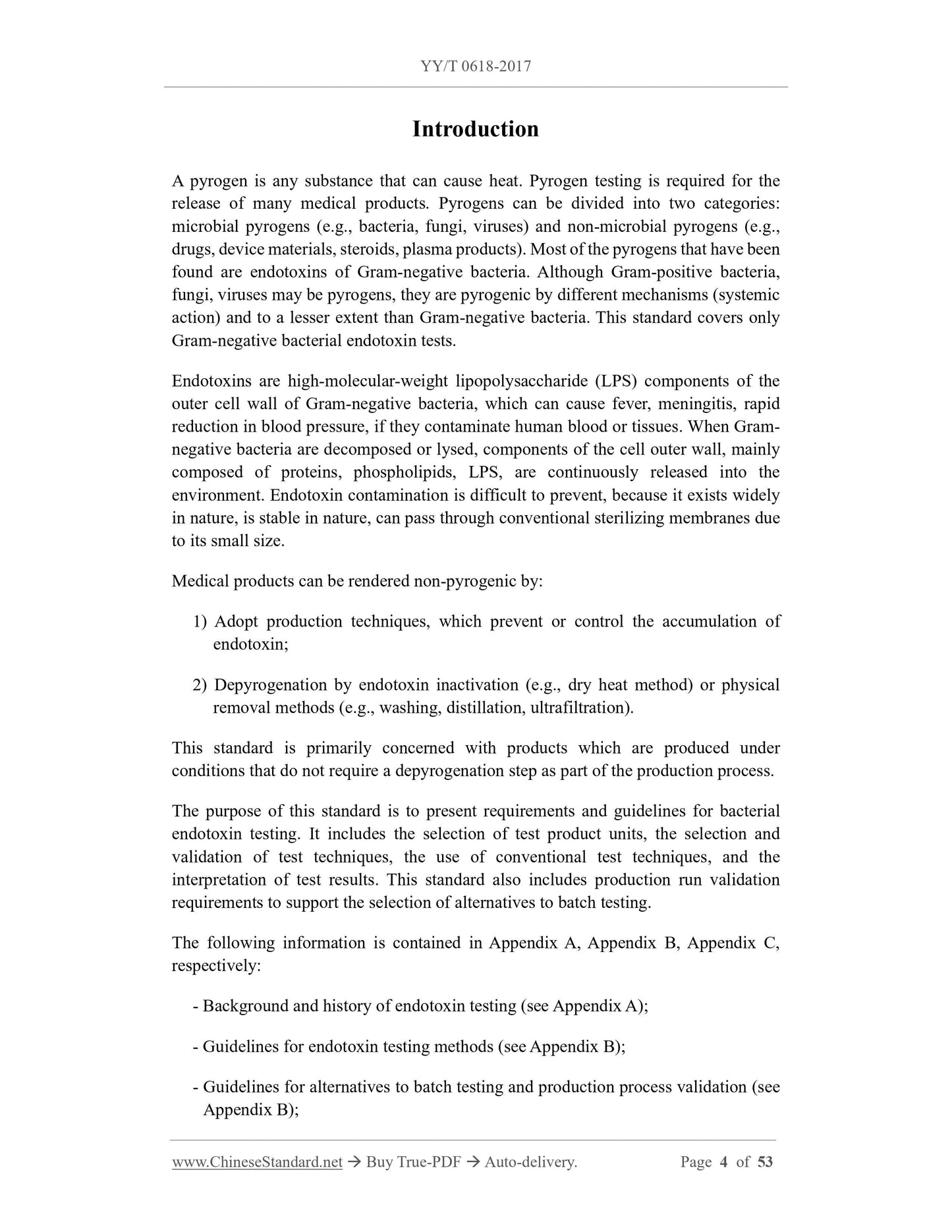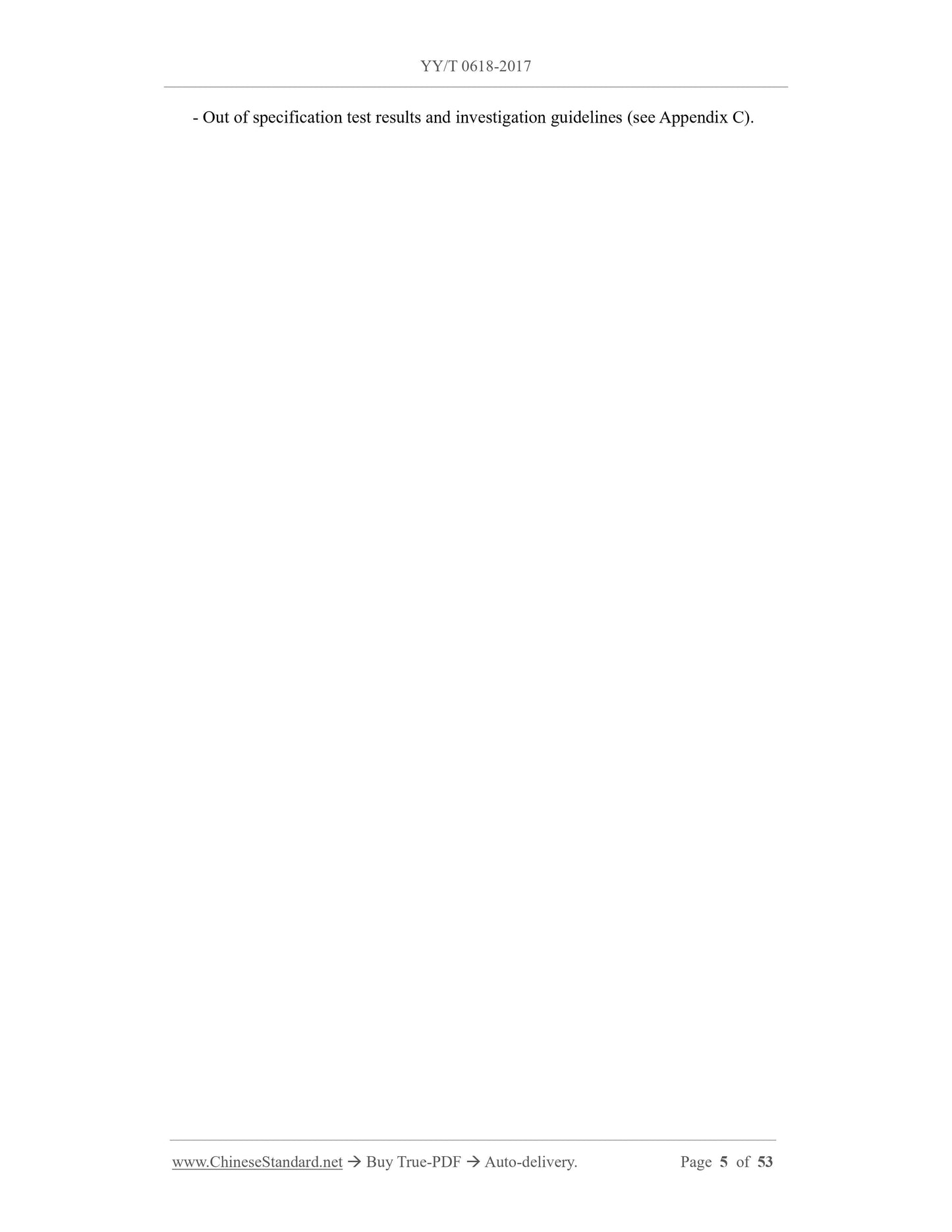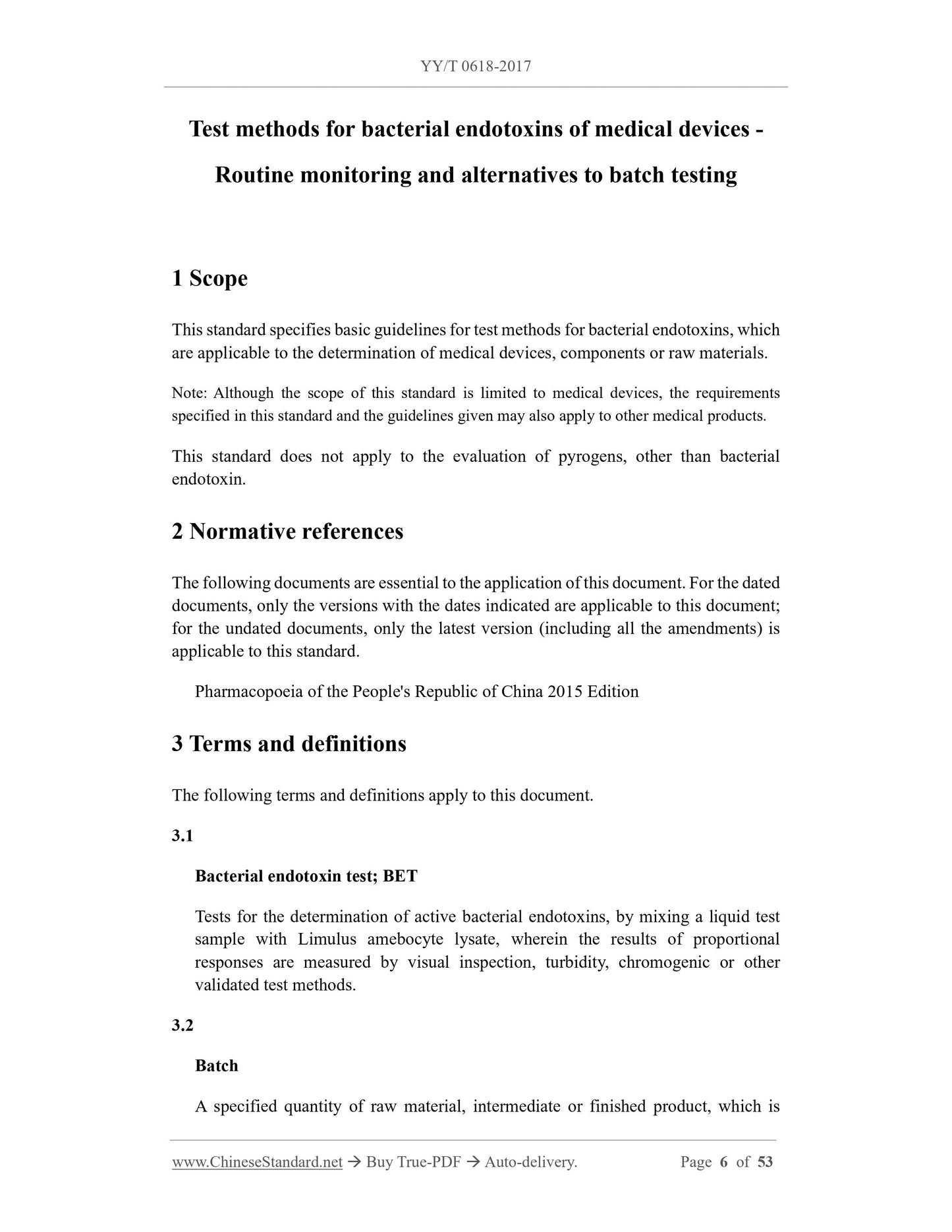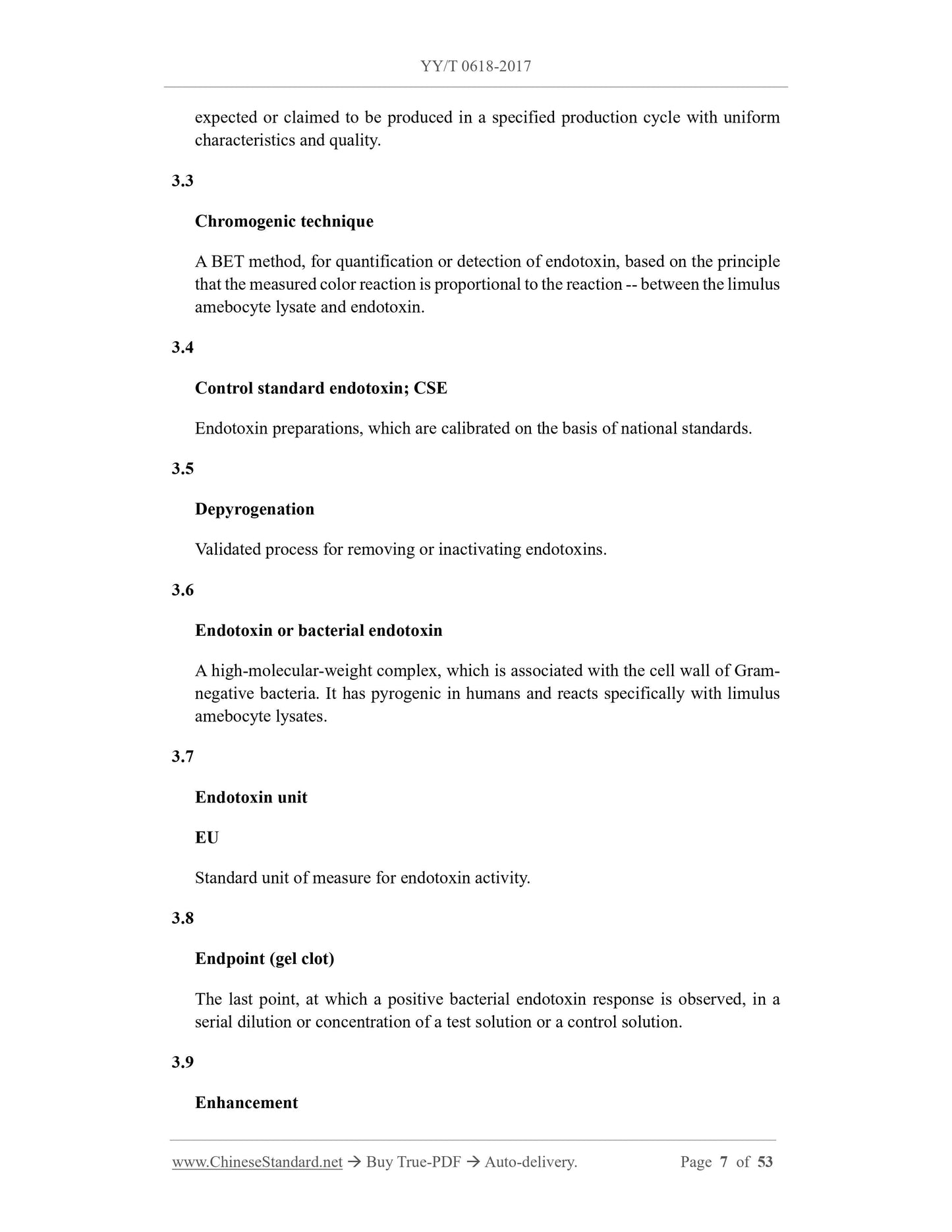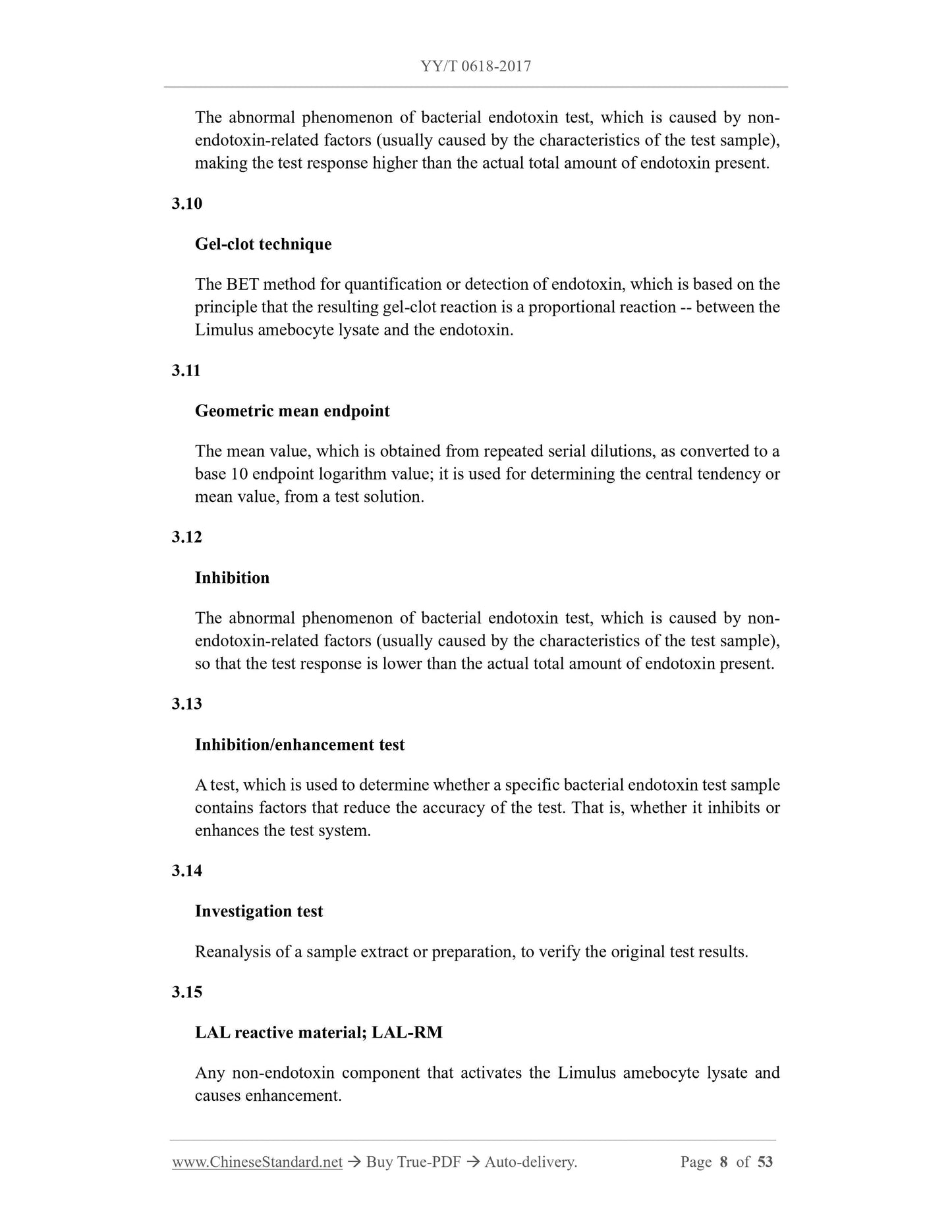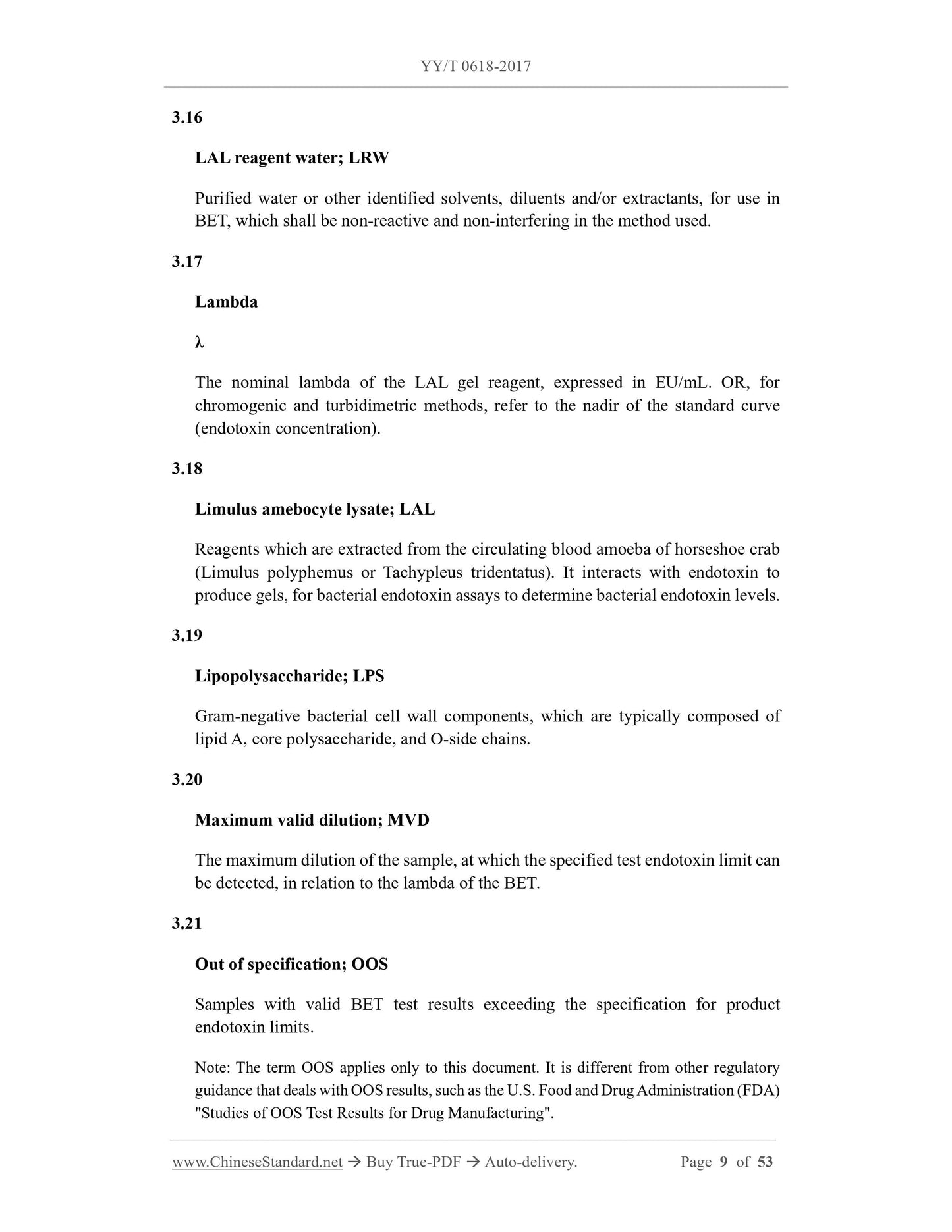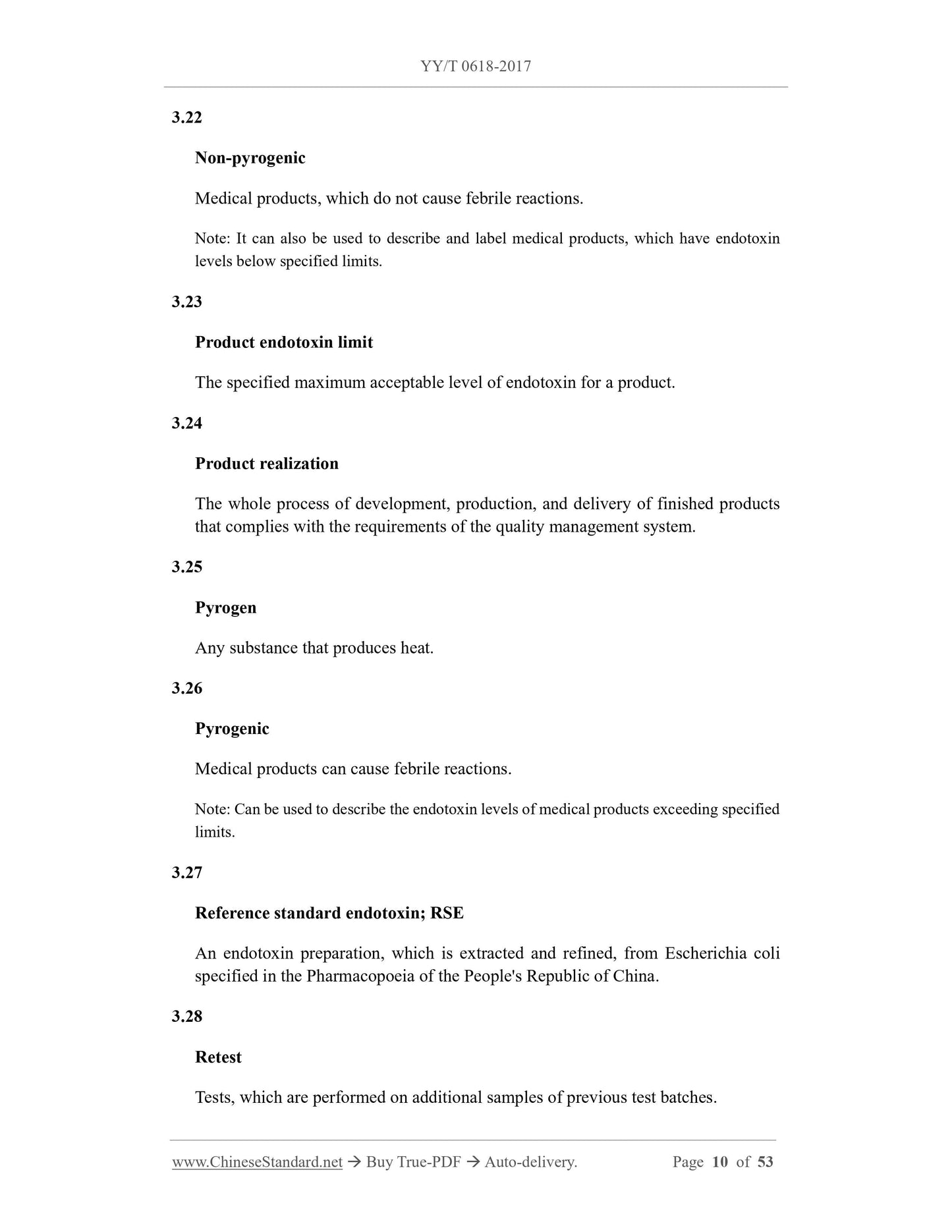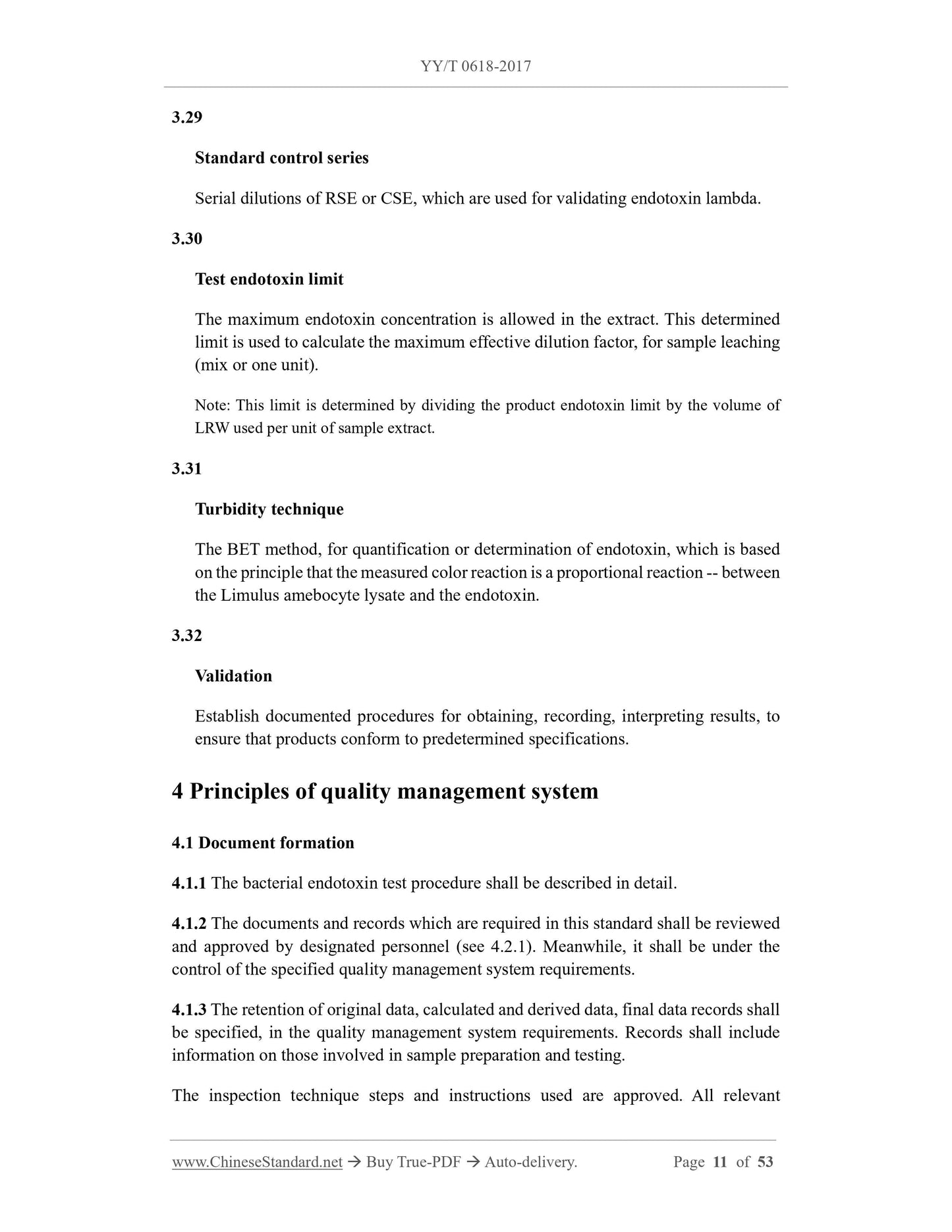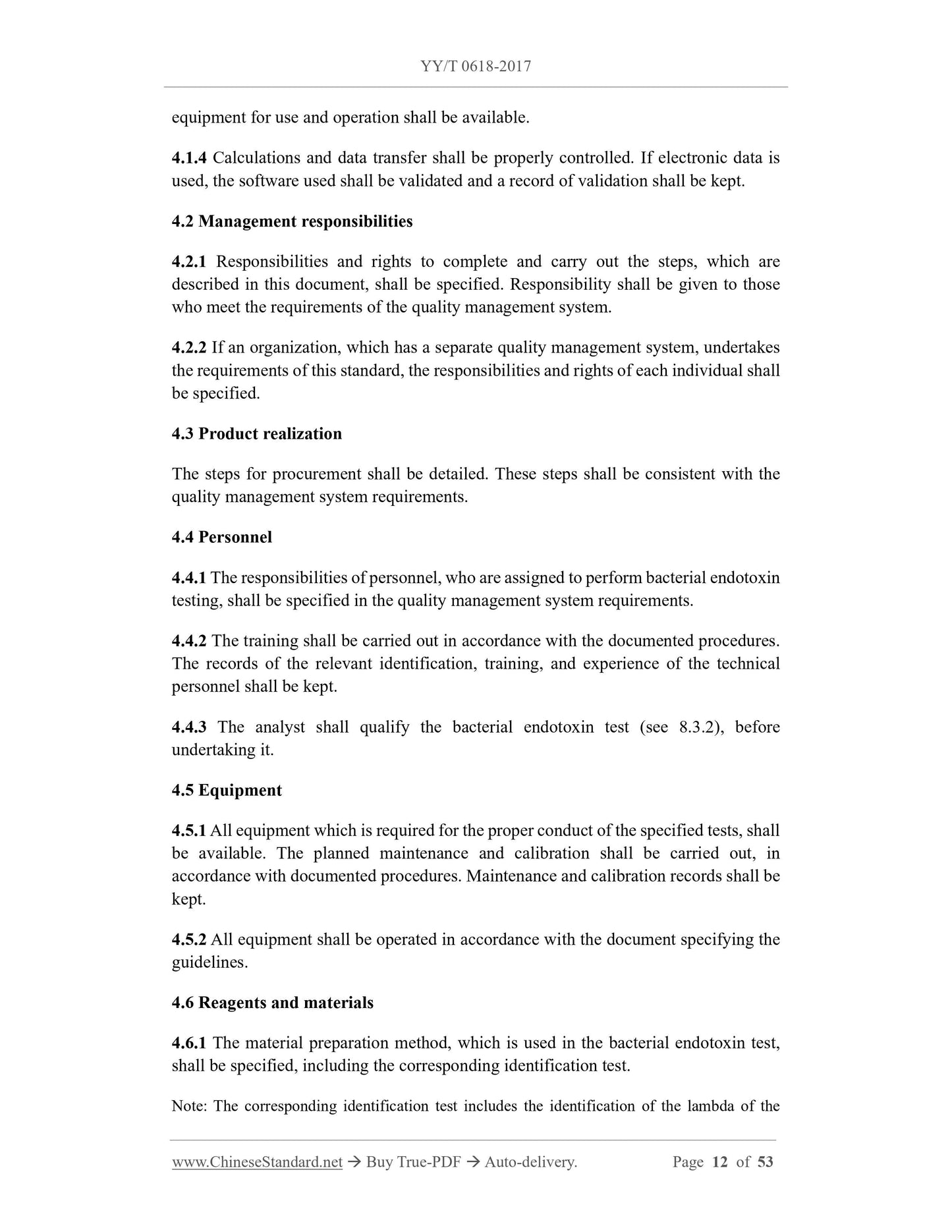1
/
su
12
PayPal, credit cards. Download editable-PDF & invoice in 1 second!
YY/T 0618-2017 English PDF (YYT0618-2017)
YY/T 0618-2017 English PDF (YYT0618-2017)
Prezzo di listino
$505.00 USD
Prezzo di listino
Prezzo scontato
$505.00 USD
Prezzo unitario
/
per
Spese di spedizione calcolate al check-out.
Impossibile caricare la disponibilità di ritiro
Delivery: 3 seconds. Download true-PDF + Invoice.
Get QUOTATION in 1-minute: Click YY/T 0618-2017
Historical versions: YY/T 0618-2017
Preview True-PDF (Reload/Scroll if blank)
YY/T 0618-2017: Test methods for bacterial endotoxins of medical devices—Routine monitoring and alternatives to batch testing
YY/T 0618-2017
YY
PHARMACEUTICAL INDUSTRY STANDARD
OF THE PEOPLE’S REPUBLIC OF CHINA
ICS 11.040.01
C30
Replacing YY/T 0618-2007
Test methods for bacterial endotoxins of medical devices -
Routine monitoring and alternatives to batch testing
ISSUED ON: FEBRUARY 28, 2017
IMPLEMENTED ON: JANUARY 01, 2018
Issued by: China Food and Drug Administration
Table of Contents
Foreword ... 3
Introduction ... 4
1 Scope ... 6
2 Normative references ... 6
3 Terms and definitions ... 6
4 Principles of quality management system ... 11
5 Non-pyrogenic label ... 13
6 Selection of product unit ... 14
7 Choice of technique ... 15
8 Methodological validation ... 15
9 Use of technique ... 20
10 Alternatives to batch testing ... 24
Appendix A (Informative) Background information on bacterial endotoxin testing .. 28
Appendix B (Informative) Guidelines for test methods, routine monitoring, alternatives
to batch testing ... 32
Appendix C (Informative) Out-of-specification (OOS) and failure investigation guide
... 50
References ... 53
Test methods for bacterial endotoxins of medical devices -
Routine monitoring and alternatives to batch testing
1 Scope
This standard specifies basic guidelines for test methods for bacterial endotoxins, which
are applicable to the determination of medical devices, components or raw materials.
Note: Although the scope of this standard is limited to medical devices, the requirements
specified in this standard and the guidelines given may also apply to other medical products.
This standard does not apply to the evaluation of pyrogens, other than bacterial
endotoxin.
2 Normative references
The following documents are essential to the application of this document. For the dated
documents, only the versions with the dates indicated are applicable to this document;
for the undated documents, only the latest version (including all the amendments) is
applicable to this standard.
Pharmacopoeia of the People's Republic of China 2015 Edition
3 Terms and definitions
The following terms and definitions apply to this document.
3.1
Bacterial endotoxin test; BET
Tests for the determination of active bacterial endotoxins, by mixing a liquid test
sample with Limulus amebocyte lysate, wherein the results of proportional
responses are measured by visual inspection, turbidity, chromogenic or other
validated test methods.
3.2
Batch
A specified quantity of raw material, intermediate or finished product, which is
The abnormal phenomenon of bacterial endotoxin test, which is caused by non-
endotoxin-related factors (usually caused by the characteristics of the test sample),
making the test response higher than the actual total amount of endotoxin present.
3.10
Gel-clot technique
The BET method for quantification or detection of endotoxin, which is based on the
principle that the resulting gel-clot reaction is a proportional reaction -- between the
Limulus amebocyte lysate and the endotoxin.
3.11
Geometric mean endpoint
The mean value, which is obtained from repeated serial dilutions, as converted to a
base 10 endpoint logarithm value; it is used for determining the central tendency or
mean value, from a test solution.
3.12
Inhibition
The abnormal phenomenon of bacterial endotoxin test, which is caused by non-
endotoxin-related factors (usually caused by the characteristics of the test sample),
so that the test response is lower than the actual total amount of endotoxin present.
3.13
Inhibition/enhancement test
A test, which is used to determine whether a specific bacterial endotoxin test sample
contains factors that reduce the accuracy of the test. That is, whether it inhibits or
enhances the test system.
3.14
Investigation test
Reanalysis of a sample extract or preparation, to verify the original test results.
3.15
LAL reactive material; LAL-RM
Any non-endotoxin component that activates the Limulus amebocyte lysate and
causes enhancement.
3.16
LAL reagent water; LRW
Purified water or other identified solvents, diluents and/or extractants, for use in
BET, which shall be non-reactive and non-interfering in the method used.
3.17
Lambda
The nominal lambda of the LAL gel reagent, expressed in EU/mL. OR, for
chromogenic and turbidimetric methods, refer to the nadir of the standard curve
(endotoxin concentration).
3.18
Limulus amebocyte lysate; LAL
Reagents which are extracted from the circulating blood amoeba of horseshoe crab
(Limulus polyphemus or Tachypleus tridentatus). It interacts with endotoxin to
produce gels, for bacterial endotoxin assays to determine bacterial endotoxin levels.
3.19
Lipopolysaccharide; LPS
Gram-negative bacterial cell wall components, which are typically composed of
lipid A, core polysaccharide, and O-side chains.
3.20
Maximum valid dilution; MVD
The maximum dilution of the sample, at which the specified test endotoxin limit can
be detected, in relation to the lambda of the BET.
3.21
Out of specification; OOS
Samples with valid BET test results exceeding the specification for product
endotoxin limits.
Note: The term OOS applies only to this document. It is different from other regulatory
guidance that deals with OOS results, such as the U.S. Food and Drug Administration (FDA)
"Studies of OOS Test Results for Drug Manufacturing".
3.29
Standard control series
Serial dilutions of RSE or CSE, which are used for validating endotoxin lambda.
3.30
Test endotoxin limit
The maximum endotoxin concentration is allowed in the extract. This determined
limit is used to calculate the maximum effective dilution factor, for sample leaching
(mix or one unit).
Note: This limit is determined by dividing the product endotoxin limit by the volume of
LRW used per unit of sample extract.
3.31
Turbidity technique
The BET method, for quantification or determination of endotoxin, which is based
on the principle that the measured color reaction is a proportional reaction -- between
the Limulus amebocyte lysate and the endotoxin.
3.32
Validation
Establish documented procedures for obtaining, recording, interpreting results, to
ensure that products conform to predetermined specifications.
4 Principles of quality management system
4.1 Document formation
4.1.1 The bacterial endotoxin test procedure shall be described in detail.
4.1.2 The documents and records which are required in this standard shall be reviewed
and approved by designated personnel (see 4.2.1). Meanwhile, it shall be under the
control of the specified quality management system requirements.
4.1.3 The retention of original data, calculated and derived data, final data records shall
be specified, in the quality management system requirements. Records shall include
information on those involved in sample preparation and testing.
The inspection technique steps and instructions used are approved. All relevant
equipment for use and operation shall be available.
4.1.4 Calculations and data transfer shall be properly controlled. If electronic data is
used, the software used shall be validated and a record of validation shall be kept.
4.2 Management responsibilities
4.2.1 Responsibilities and rights to complete and carry out the steps, which are
described in this document, shall be specified. Responsibility shall be given to those
who meet the requirements of the qua...
Get QUOTATION in 1-minute: Click YY/T 0618-2017
Historical versions: YY/T 0618-2017
Preview True-PDF (Reload/Scroll if blank)
YY/T 0618-2017: Test methods for bacterial endotoxins of medical devices—Routine monitoring and alternatives to batch testing
YY/T 0618-2017
YY
PHARMACEUTICAL INDUSTRY STANDARD
OF THE PEOPLE’S REPUBLIC OF CHINA
ICS 11.040.01
C30
Replacing YY/T 0618-2007
Test methods for bacterial endotoxins of medical devices -
Routine monitoring and alternatives to batch testing
ISSUED ON: FEBRUARY 28, 2017
IMPLEMENTED ON: JANUARY 01, 2018
Issued by: China Food and Drug Administration
Table of Contents
Foreword ... 3
Introduction ... 4
1 Scope ... 6
2 Normative references ... 6
3 Terms and definitions ... 6
4 Principles of quality management system ... 11
5 Non-pyrogenic label ... 13
6 Selection of product unit ... 14
7 Choice of technique ... 15
8 Methodological validation ... 15
9 Use of technique ... 20
10 Alternatives to batch testing ... 24
Appendix A (Informative) Background information on bacterial endotoxin testing .. 28
Appendix B (Informative) Guidelines for test methods, routine monitoring, alternatives
to batch testing ... 32
Appendix C (Informative) Out-of-specification (OOS) and failure investigation guide
... 50
References ... 53
Test methods for bacterial endotoxins of medical devices -
Routine monitoring and alternatives to batch testing
1 Scope
This standard specifies basic guidelines for test methods for bacterial endotoxins, which
are applicable to the determination of medical devices, components or raw materials.
Note: Although the scope of this standard is limited to medical devices, the requirements
specified in this standard and the guidelines given may also apply to other medical products.
This standard does not apply to the evaluation of pyrogens, other than bacterial
endotoxin.
2 Normative references
The following documents are essential to the application of this document. For the dated
documents, only the versions with the dates indicated are applicable to this document;
for the undated documents, only the latest version (including all the amendments) is
applicable to this standard.
Pharmacopoeia of the People's Republic of China 2015 Edition
3 Terms and definitions
The following terms and definitions apply to this document.
3.1
Bacterial endotoxin test; BET
Tests for the determination of active bacterial endotoxins, by mixing a liquid test
sample with Limulus amebocyte lysate, wherein the results of proportional
responses are measured by visual inspection, turbidity, chromogenic or other
validated test methods.
3.2
Batch
A specified quantity of raw material, intermediate or finished product, which is
The abnormal phenomenon of bacterial endotoxin test, which is caused by non-
endotoxin-related factors (usually caused by the characteristics of the test sample),
making the test response higher than the actual total amount of endotoxin present.
3.10
Gel-clot technique
The BET method for quantification or detection of endotoxin, which is based on the
principle that the resulting gel-clot reaction is a proportional reaction -- between the
Limulus amebocyte lysate and the endotoxin.
3.11
Geometric mean endpoint
The mean value, which is obtained from repeated serial dilutions, as converted to a
base 10 endpoint logarithm value; it is used for determining the central tendency or
mean value, from a test solution.
3.12
Inhibition
The abnormal phenomenon of bacterial endotoxin test, which is caused by non-
endotoxin-related factors (usually caused by the characteristics of the test sample),
so that the test response is lower than the actual total amount of endotoxin present.
3.13
Inhibition/enhancement test
A test, which is used to determine whether a specific bacterial endotoxin test sample
contains factors that reduce the accuracy of the test. That is, whether it inhibits or
enhances the test system.
3.14
Investigation test
Reanalysis of a sample extract or preparation, to verify the original test results.
3.15
LAL reactive material; LAL-RM
Any non-endotoxin component that activates the Limulus amebocyte lysate and
causes enhancement.
3.16
LAL reagent water; LRW
Purified water or other identified solvents, diluents and/or extractants, for use in
BET, which shall be non-reactive and non-interfering in the method used.
3.17
Lambda
The nominal lambda of the LAL gel reagent, expressed in EU/mL. OR, for
chromogenic and turbidimetric methods, refer to the nadir of the standard curve
(endotoxin concentration).
3.18
Limulus amebocyte lysate; LAL
Reagents which are extracted from the circulating blood amoeba of horseshoe crab
(Limulus polyphemus or Tachypleus tridentatus). It interacts with endotoxin to
produce gels, for bacterial endotoxin assays to determine bacterial endotoxin levels.
3.19
Lipopolysaccharide; LPS
Gram-negative bacterial cell wall components, which are typically composed of
lipid A, core polysaccharide, and O-side chains.
3.20
Maximum valid dilution; MVD
The maximum dilution of the sample, at which the specified test endotoxin limit can
be detected, in relation to the lambda of the BET.
3.21
Out of specification; OOS
Samples with valid BET test results exceeding the specification for product
endotoxin limits.
Note: The term OOS applies only to this document. It is different from other regulatory
guidance that deals with OOS results, such as the U.S. Food and Drug Administration (FDA)
"Studies of OOS Test Results for Drug Manufacturing".
3.29
Standard control series
Serial dilutions of RSE or CSE, which are used for validating endotoxin lambda.
3.30
Test endotoxin limit
The maximum endotoxin concentration is allowed in the extract. This determined
limit is used to calculate the maximum effective dilution factor, for sample leaching
(mix or one unit).
Note: This limit is determined by dividing the product endotoxin limit by the volume of
LRW used per unit of sample extract.
3.31
Turbidity technique
The BET method, for quantification or determination of endotoxin, which is based
on the principle that the measured color reaction is a proportional reaction -- between
the Limulus amebocyte lysate and the endotoxin.
3.32
Validation
Establish documented procedures for obtaining, recording, interpreting results, to
ensure that products conform to predetermined specifications.
4 Principles of quality management system
4.1 Document formation
4.1.1 The bacterial endotoxin test procedure shall be described in detail.
4.1.2 The documents and records which are required in this standard shall be reviewed
and approved by designated personnel (see 4.2.1). Meanwhile, it shall be under the
control of the specified quality management system requirements.
4.1.3 The retention of original data, calculated and derived data, final data records shall
be specified, in the quality management system requirements. Records shall include
information on those involved in sample preparation and testing.
The inspection technique steps and instructions used are approved. All relevant
equipment for use and operation shall be available.
4.1.4 Calculations and data transfer shall be properly controlled. If electronic data is
used, the software used shall be validated and a record of validation shall be kept.
4.2 Management responsibilities
4.2.1 Responsibilities and rights to complete and carry out the steps, which are
described in this document, shall be specified. Responsibility shall be given to those
who meet the requirements of the qua...
Share
